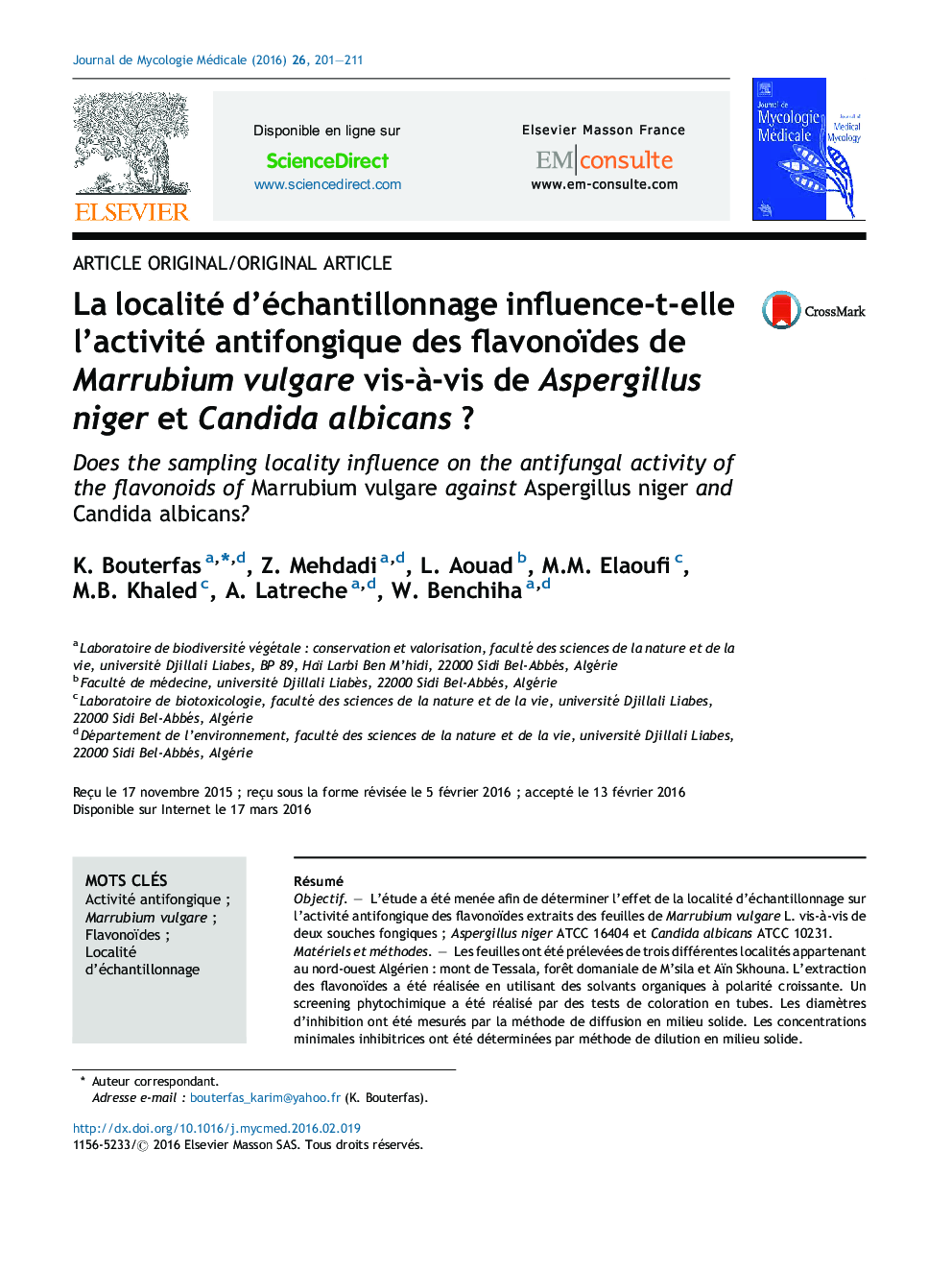| Article ID | Journal | Published Year | Pages | File Type |
|---|---|---|---|---|
| 3219043 | Journal de Mycologie Médicale / Journal of Medical Mycology | 2016 | 11 Pages |
RésuméObjectifL’étude a été menée afin de déterminer l’effet de la localité d’échantillonnage sur l’activité antifongique des flavonoïdes extraits des feuilles de Marrubium vulgare L. vis-à-vis de deux souches fongiques ; Aspergillus niger ATCC 16404 et Candida albicans ATCC 10231.Matériels et méthodesLes feuilles ont été prélevées de trois différentes localités appartenant au nord-ouest Algérien : mont de Tessala, forêt domaniale de M'sila et Aïn Skhouna. L’extraction des flavonoïdes a été réalisée en utilisant des solvants organiques à polarité croissante. Un screening phytochimique a été réalisé par des tests de coloration en tubes. Les diamètres d’inhibition ont été mesurés par la méthode de diffusion en milieu solide. Les concentrations minimales inhibitrices ont été déterminées par méthode de dilution en milieu solide.RésultatsL’activité antifongique varie significativement (p < 0,001) en fonction de la localité d’échantillonnage des feuilles, de l’extrait flavonoïque testé et de sa concentration, et du type de la souche fongique. Les diamètres d’inhibition enregistrés oscillent entre 8,16 et 37,5 mm enregistrant même une inhibition totale de la croissance fongique et dépassent souvent ceux induits par les antifongiques commercialisés (Amphotéricine, Fluconazole, Terbinafine et le nitrate d’éconazole). Les concentrations minimales inhibitrices (CMI) obtenues varient entre 6,25 et 100 μg/mL enregistrant une forte inhibition antifongique. Le screening phytochimique a révélé l’existence de certaines classes flavonoïques telles que les flavanes et les flavanols qui pourraient être responsables de ce remarquable pouvoir antifongique.ConclusionLa localité d’échantillonnage des feuilles de Marrubium vulgare influence nettement l’activité antifongique des flavonoïdes. Ces derniers se sont avérés de très bons fongistatiques et qui méritent d’être valorisés en pharmacologie.
SummaryObjectiveThe study was undertaken to determine the effect of the sampling locality on the antifungal activity of the flavonoids extracted from the leaves of Marrubium vulgare L. against two fungal strains; Aspergillus niger ATCC 16404 and Candida albicans ATCC 10231.Materials and methodsThe leaves were collected from three different sampling localities belonging northwest Algeria: Tessala mount, M'sila forest and Ain Skhouna. The flavonoid extraction was carried out by using organic solvents with increasing polarity. A phytochemical screening was performed by staining test tubes. The inhibition diameters were measured by solid medium diffusion method. The minimum inhibitory concentrations were determined by dilution method on solid medium.ResultsThe antifungal activity varied significantly (P < 0.001) according to the sampling locality of the leaves, the flavonoid extract and its concentration, and the strain fungal type. The inhibition diameters varied between 8.16 and recorded 37.5 mm even recording a total inhibition of fungal growth and often exceed those induced marketed antifungals (Amphotericin, Fluconazole, Terbinafine and econazole nitrate). The minimum inhibitory concentrations (MICs) obtained range between 6.25 and 100 μg/mL; experiencing strong antifungal inhibition. The phytochemical screening revealed the existence of certain flavonoids classes such as flavans and flavanols which may be responsible of this remarkable antifungal power.ConclusionThe sampling locality of Marrubium vulgare leaves influenced on the antifungal activity of flavonoids. These have proven very good fungistatic and worth valuing in pharmacology.
